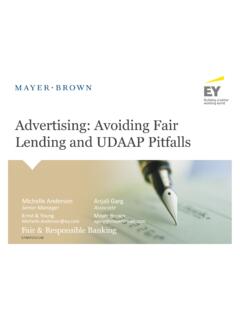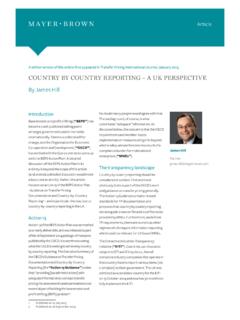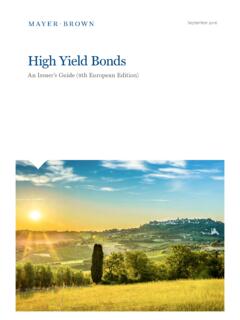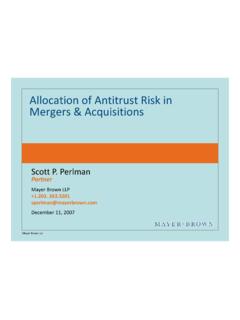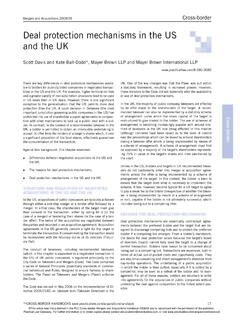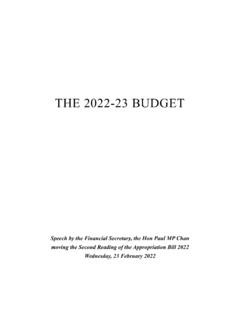Transcription of Hong Kong Initial Public Offerings - Mayer Brown
1 An Issuer s GuideHong kong Initial Public OfferingsThis Mayer Brown publication provides information and comments on legal issues and developments of interest to our clients and friends. The foregoing is intended to provide a general guide to the subject matter and is not intended to provide legal advice or be a substitute for specific advice concerning individual situations. Readers should seek legal advice before taking any action with respect to the matters discussed Issuer s GuideHong kong Initial Public Offeringsiv | hong kong Initial Public Offerings An Issuer s GuideChapter 1 Introduction ..1 Getting Ready for an IPO ..2 Analysing and Simplifying the Existing Capital Structure 3 Revisiting Relationship with Key Shareholders and other Related Parties 4 Designing the Right Corporate Governance Structure 4 Motivating EmployeesPre-IPO Investments 6 Determining the Appropriate Offering Structure 7 Engaging Investors 7 Key Parties.
2 9 Listing Applicant 9 Selling Shareholders 10 Management of the Listing Applicant 10 Auditors/Reporting Accountant of the Listing Applicant 10 Sponsors and Underwriters 11 Legal Advisers 12 Other Parties 12 Key Documents ..13 Prospectus 13 General Form and Content 14 Risk Factors Section 15 Business Section 16 Financial Information Section 21 Financial Statements 24 Engagement Letter with the Investment Banks 26 Underwriting Agreement 27 Lock-up Agreements 30 Legal Opinions and Disclosure Letters 31 Comfort Letters 32 Chapter 2 Listing in hong kong ..34 The Regulatory Considerations ..36 Sole Listing vs. Dual Listing 36 Primary Listing vs. Secondary Listing 36 Holistic Listing vs. Listing of Regional Subsidiaries 36 Listing of Shares vs. hong kong Depositary Receipts 37 IPO vs Introduction 37 CONTENTSMAYER Brown | vAdmission Criteria ..38 Main Board Listing Criteria 38 GEM Listing Criteria 39 Overseas Companies Recognised or Approved Jurisdictions.
3 39 The Joint Policy Statement 40 Acceptable Jurisdictions 41 Group Reorganisation and Pre-IPO Financing ..41 Group Reorganisation 41 Pre-IPO Financing 41 General Principles: Fair and Equal 42 Special Rights attached to Pre-IPO Investments 43 Pre-IPO Investments in the form of Convertible Instruments 44 Public Float Consideration 45 Structure of the Offering ..46 hong kong Public Offering and International Offering 46 International Offering as Exempt Offering under the US Securities Law 46 Rule 144A 47 Regulation S 47 Liability on Disclosure 49 Special Consideration ..49 Listing with a WVR Structure 49 Listing of Biotech companies 51 The New Concessionary Secondary Listing Regime 56 Listing using a VIE Structure 58 Use of Proceeds 59 Chapter 3 The hong kong IPO Timetable ..61 Stage 1: Initial Preparation ..62 Building a Team 62 Sponsor 62 Other Professional Parties 63 Internal Corporate Structure 63 Kick-Off Meeting 64 Publicity Considerations 64 General Guidelines 64US Publicity Considerations 65 Publicity Guidelines 67 CONTENTSvi | hong kong Initial Public Offerings An Issuer s GuideThe Due Diligence Review 69 General Guidelines 69 Conducting Due Diligence 71 Prospectus Drafting 72 Prospectus Liability 72 Prospectus Content 73 Drafting Responsibility and Drafting Sessions 74 Submission of the listing application package 75 Stage 2: Regulatory Vetting.
4 75 Regulators Review 75 Responding to Comments from The Regulators 76 Hearing 76 Stage 3: Marketing and Offering ..76 Pre-Marketing and Pre-Deal Research 76 Book-Building and Roadshow 78 hong kong Public Offering 79 Price Determination 79 Allocation and Settlement 79 Chapter 4 Ongoing Obligations of Listed Companies in hong kong ..81 Compliance Adviser ..82 Disclosure Obligations ..83 Disclosure of Specific Matters 84 Results Announcements and Financial Reports 85 Corporate Governance Report 86 Environmental, Social and Governance ( Esg ) Report 86 Disclosure of Interest 87 Takeover s 87 Appendix ..88 Appendix 1: HKEX Listing Criteria ..89 Appendix 2: Mining and Mineral Companies ..92 Appendix 3: Waivers ..95 Appendix 4: Connected Transactions ..97 Appendix 5: Corporate Governance ..105 Appendix 6: Directors Duties ..107 CONTENTSMAYER Brown | 1 IntroductionChapter 12 | hong kong Initial Public Offerings An Issuer s GuideFor most companies and their owners, an Initial Public offering (IPO) is a once-in-a-lifetime event that represents the culmination of many years of hard work and personal investment.
5 While an IPO is no doubt one of the most important milestones in the corporate evolution of a company, it also brings with it significant changes to the way the company operates and conducts itself. The legal and compliance obligations imposed on a Public company and its ongoing compliance challenges need to be fully guide provides an overview of some of the key issues with which we believe all directors, members of senior management, general counsel and other key decision makers of a potential IPO candidate should be familiar, and focuses on a listing on The Stock Exchange of hong kong Limited (HKEx). However, this guide is neither intended to be a comprehensive treatment of the subject matter or of all matters relevant to an IPO, nor as a substitute for legal advice. We encourage readers to reach out to the authors of this guide or any of the other key members of our Asian Equity Capital Markets Practice before taking any Ready for an IPOP rior to going Public , the owners and management of a potential IPO candidate, in consultation with their advisers, must implement a corporate governance structure and other internal procedures and guidelines that are suitable for its life as a Public company.
6 Key steps in getting ready for an IPO may include: Simplifying the company s capital structure. Moving assets out of or into the entity or group that will be listed. Intra-group restructuring to make the company operate in a more tax-efficient manner. Formalising and properly documenting any existing relationships and commercial dealings between the company and its owners. Addressing internal housekeeping matters, such as reviewing and amending the company s constitutional documents, committee charters or other organisational Brown | 3 Putting in place a corporate governance structure suitable for a Public company, including a board of directors with independent members and various committees necessary for a Public company. Reviewing and organising the company s financial records. Establishing or reviewing, together with its auditors, the company s internal controls and creating procedures to support the ongoing Public reporting of a Public company.
7 Reviewing, amending and implementing appropriate compensation, (equity) incentive and pension arrangements. Considering the need of getting pre-IPO investments. Reviewing the company s policies for corporate communications and establishing a formal investor relations programme. Creating, reviewing and updating a website suitable for a Public AND SIMPLIFYING THE EXISTING CAPITAL STRUCTUREMany potential IPO candidates may have raised capital in the past from private equity or venture capital investors for more than one funding round. As a result, it is not uncommon to find IPO candidates with highly complex share capital structures that may comprise multiple classes of ordinary and preferred shares. The existence of options, warrants, or convertible bonds can further complicate matters. It may therefore be necessary to simplify significantly the share capital structure of the IPO candidate and, ideally, convert or collapse the different classes of shares into a single class of ordinary shares on or before the IPO date.
8 See Special Considerations Listing with a WVR Structure the pre-IPO reorganization, individual shareholders of the IPO candidate may also consider the need for setting up a family trust for the purpose of holding shares in the listing vehicle, which is considered to be the most common and advantageous structure for families and business owners. There are various benefits of using a trust structure. For example, a family can safeguard against losing its control of the business in the future through events like third party creditors claims and a trust structure also can enable succession planning, tax efficiency and risk | hong kong Initial Public Offerings An Issuer s GuideREVISITING RELATIONSHIP WITH KEY SHAREHOLDERS AND OTHER RELATED PARTIESAn IPO candidate and its key shareholders are often parties to a sharehold-ers agreement that governs their relationship (for example, how corporate decisions are made; who has a right to nominate or appoint directors; under what circumstances shareholders can sell their shares or their actions be restricted).
9 Again, it may be necessary to terminate or substantially revise them on or prior to the IPO date. If there will continue to be a con-trolling shareholder after the IPO, applicable listing rules and market expectations may require that this relationship be formalised, and appropri-ate protections for non-controlling/minority shareholders be put in shareholders of an IPO candidate and their associates may also be significant customers or suppliers of the company or they may have other significant relationships. For example, the founder or controlling share-holder, rather than the company itself, may be the legal owner of key operating assets or intellectual property rights that the IPO candidate relies on to operate its business. Formalising and properly documenting these connected transactions and commercial arrangements among the IPO candidate and its owners on arm s-length terms and properly describ-ing them in the IPO prospectus can be crucial for the success of the IPO.
10 This may involve entering into formal, long-term, purchase, supply or licensing agreements with or transferring key assets to the IPO addition, an IPO candidate must be capable of carrying on its business independently of its controlling shareholder(s) (including any close associ-ate of such controlling shareholder(s)) after listing. The IPO candidate will usually need to demonstrate its independence from the controlling share-holder(s) from financial, operational and management aspects. Where the degree of dependence on its controlling shareholder(s) is excessive, it may raise concerns about the IPO candidate s suitability for THE RIGHT CORPORATE GOVERNANCE STRUCTURE Corporate governance structures that may be appropriate, and may even have proven to be highly effective for a particular company in the pre-IPO world, may be unsuitable for a company once its shares are publicly listed. The IPO candidate and its owners, with support from their financial and Mayer Brown | 5legal advisers, will therefore need to review carefully and, in all likelihood, supplement or possibly even completely replace, existing corporate governance structures in preparation for a proposed IPO.


